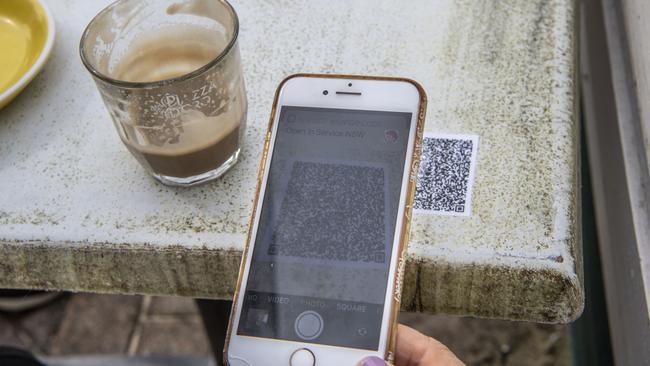QR code sign in complacency left Melbourne unprepared for major coronavirus outbreak
When Covid reappeared in Melbourne, contact tracers raced to collect QR code data from businesses — but what they found didn’t add up.
News
Don't miss out on the headlines from News. Followed categories will be added to My News.
When coronavirus reared its head in Melbourne again late last month, contact tracers raced to collect data from businesses showing who had visited at-risk locations.
In the city’s northern suburbs, where the virus had taken a particularly tight grip, one venue’s records showed 27 people had “checked in” digitally or physically at a time when an infectious Victorian may have been nearby.
After taking the time to crosscheck CCTV and financial records, contact tracers discovered there had actually been 122 people brushing shoulders with a COVID-19 patient.
Government and health authorities had been fretting about poor record-keeping at Melbourne venues for months.
Last year there had been a rush by the hospitality and entertainment industries to develop QR codes for digital check-ins.
Customers were encouraged to point their smartphone at the barcode-like image, allowing them to open up a web page or app where they could enter contact details.
If an outbreak occurred and a sick person had been in the same venue, they would be contacted.
Despite initial goodwill, uptake remained relatively low.
In November, the government launched its own QR code system through its Service Victoria app — but it was not mandatory.

Insiders say keeping a variety of QR code systems in place may have contributed to complacency.
Others said information campaigns about the importance of leaving a digital footprint behind to keep Victorian open were limited at best.
The Department of Premier and Cabinet — which is responsible for Service Victoria — resisted migrating all businesses to one system because many had sunk time and money into developing separate systems.
Instead it developed a “back of house” product that collated data fed through by venues.
“A whole lot of businesses signed up for a year, and do you throw them all out or create an API (Application Programming Interface) that is a back of house thing that feeds all the data through?” one insider said.
“At the same time, it’s just easier for people if you have got one code and they are more likely to use it.”
Service NSW, which is a more advanced government app, has been mandatory since January. In that month alone more than 60 million people checked in, and user profiles include more detailed information including user driver's licences.
To put that in perspective, 40 million check-ins have been recorded through the Service Victoria app since November 30.

Earlier this year the Department of Health showed signs it didn’t trust Victoria’s system to deliver what was needed during a major outbreak.
When the Queen Victoria Market proposed reopening its successful night market series for winter, which could attract 10,000 visitors it pledged staff would be on gates to ensure 100 per cent QR code adherence.
Government officials asked that the free event be ticketed, instead, creating an extra cost.
At Easter, Government Services Minister Danny Pearson announced a blitz would be carried out to monitor compliance at venues.
Despite the warning, Pearson later revealed that 37 per cent of those visited were “flagged as non-compliant with QR code check-in rules”.
Eventually, on May 7, the government announced that venues had three weeks to migrate to the Service Victoria system.
Pubs and restaurants backed the change because it allowed for more customers to be jammed into venues.
In a sign it was still wary, the government announced a $1652 fine for “any business ignoring its responsibility to help Victoria stay safe and stay open”.
Just before the state’s app became mandatory, there was a major outbreak of COVID-19 and
Melbourne went into lockdown.
A number of bars and clubs along the popular Chapel Street were identified as hot spots, and the use of QR codes was poor.

Suddenly, the rhetoric from government shifted, with even “fleeting” contact between an infected patient and a punter able to set off a virus cluster.
It was panic stations.
By Wednesday, when the government realised it would be facing a longer lockdown than anticipated and billions of dollars in lost revenue to businesses, it pulled a new lever.
All retail outlets would have to force customers to sign in upon entry, including supermarkets and takeaway cafes.
Previously, customers only had to sign in if inside a venue for 15 minutes.
Supermarkets were compliant, but staff worried about angst from shoppers being forced to leave a digital presence and said they couldn’t force customers to sign in.
Perhaps sensing concerns, Acting Premier James Merlino revealed on Thursday that police would do spot checks in stores.
Earlier in the week Chief Health Officer Brett Sutton said a lot had changed when it came to QR code procedures, but it would help his team tackle outbreaks.
“We’re in a position now where the Victorian community is motivated to do the right thing,” he said.
Lockdowns do that to you.
Over in NSW, where contact tracing was spruiked as “gold standard” last year by Victorian Liberal MPs, Premier Gladys Berejiklian chimed in, saying that having multiple sign-in processes “makes the job a bit more difficult in terms of contact tracing”.
“We’ve had our system in place for some time. So we have that level of confidence in NSW that we’re able to give our contact tracers that information,” she said.
It was a reminder of another way Victoria had been forced to play catch-up to NSW since this pandemic broke out.





